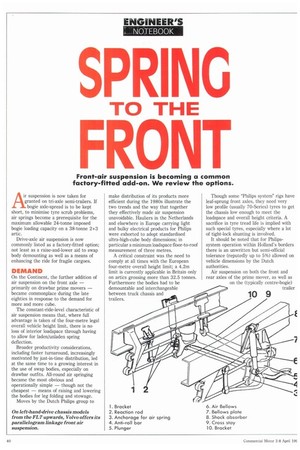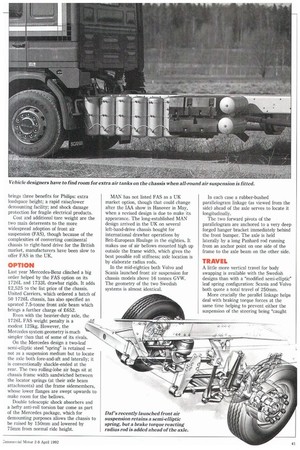SPRING
Page 42

Page 43

If you've noticed an error in this article please click here to report it so we can fix it.
FRTOIDTHNE Airsuspension is now taken for granted on tri-axle semi-trailers. If bogie axle-spread is to be kept short, to minimise tyre scrub problems, air springs become a prerequisite for the maximum allowable 24-tonne imposed bogie loading capacity on a 38-tonne 2+3 artic.
Drive-axle air suspension is now commonly listed as a factory-fitted option; not least as a raise-and-lower aid to swap body demounting as well as a means of enhancing the ride for fragile cargoes.
DEMAND
On the Continent, the further addition of air suspension on the front axle — primarily on drawbar prime movers — became commonplace during the late eighties in response to the demand for more and more cube.
The constant-ride-level characteristic of air suspension means that, where full advantage is taken of the four-metre legal overall vehicle height limit, there is no loss of interior loadspace through having to allow for laden/unladen spring deflection.
Broader productivity considerations, including faster turnaround, increasingly motivated by just-in-time distribution, led at the same time to a growing interest in the use of swap bodies, especially on drawbar outfits. All-round air springing became the most obvious and operationally simple — though not the cheapest — means of raising and lowering the bodies for leg folding and stowage.
Moves by the Dutch Philips group to make distribution of its products more efficient during the 1980s illustrate the two trends and the way that together they effectively made air suspension unavoidable. Hauliers in the Netherlands and elsewhere in Europe carrying light and bulky electrical products for Philips were exhorted to adopt standardised ultra-high-cube body dimensions; in particular a minimum loadspace floor-to-roof measurement of three metres.
A critical constraint was the need to comply at all times with the European four-metre overall height limit; a 4.2m limit is currently applicable in Britain only on artics grossing more than 32.5 tonnes. Furthermore the bodies had to be demountable and interchangeable between truck chassis and trailers. Though some 'Philips system" rigs have leaf-sprung front axles, they need very low profile (usually 70-Series) tyres to get the chassis low enough to meet the loadspace and overall height criteria. A sacrifice in tyre tread life is implied with such special tyres, especially where a lot of tight-lock shunting is involved.
It should be noted that for Philipssystem operation within Holland's borders there is an unwritten but semi-official tolerance (reputedly up to 5%) allowed on vehicle dimensions by the Dutch authorities.
Air suspension on both the front and rear axles of the prime mover, as well as brings three benefits for Philips: extra loadspace height; a rapid raise/lower demounting facility; and shock damage protection for fragile electrical products.
Cost and additional tare weight are the two main deterrents to the more widespread adoption of front air suspension (FAS), though because of the complexities of converting continental chassis to right-hand drive for the British market, manufacturers have been slow to offer FAS in the UK.
Last year Mercedes-Benz clinched a big order helped by the FAS option on its 1726L and 1733L drawbar rigids. It adds £2,525 to the list price of the chassis. United Carriers, which ordered a batch of 50 1726L chassis, has also specified an uprated 7.5-tonne front axle beam which brings a further charge of £652.
Even with the heavier-duty axle, the 1726L FAS weight penalty is a modest 125kg. However, the , Mercedes system geometry is much simpler than that of some of its rivals.
On the Mercedes design a two-leaf semi-elliptic steel "spring" is retained — not as a suspension medium but to locate the axle both fore-and-aft and laterally; it is conventionally shackle-ended at the rear. The two rolling-lobe air bags sit at chassis frame width sandwiched between the locator springs (at their axle beam attachments) and the frame sidemembers, whose lower flanges are swept upwards to make room for the bellows.
Double telescopic shock absorbers and a hefty anti-roll torsion bar come as part of the Mercedes package, which for demounting purposes allows the chassis to be raised by 150nun and lowered by 75mm from normal ride height. MAN has not listed FAS as a UK market option, though that could change after the IAA show in Hanover in May, when a revised design is due to make its appearance. The long-established MAN design arrived in the UK on several left-hand-drive chassis bought for international drawbar operations by Brit-European Haulage in the eighties. It makes use of air bellows mounted high up outside the frame width, which gives the best possible roll stiffness; axle location is by elaborate radius rods.
in the mid-eighties both Volvo and Scania launched front air suspension for chassis models above 16 tonnes GVW. The geometry of the two Swedish systems is almost identical. parallelogram linkage (as viewed from the side) ahead of the axle serves to locate it longitudinally.
The two forward pivots of the parallelogram are anchored to a very deep forged hanger bracket immediately behind the front bumper. The axle is held laterally by a long Panhard rod running from an anchor point on one side of the frame to the axle beam on the other side.
A little more vertical travel for body swapping is available with the Swedish designs than with a "modified semi-elliptic" leaf spring configuration: Scania and Volvo both quote a total travel of 250mm.
More crucially the parallel linkage helps deal with braking torque forces at the same time helping to prevent either the suspension of the steering being "caught
















































































































